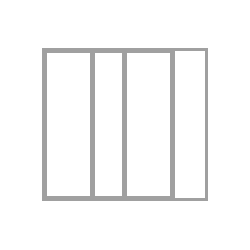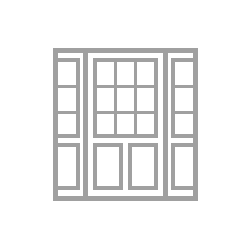One of a home’s most important features is its windows. In addition to performing necessary roles like exits, sunlight, and ventilation, they also offer immense visual design value.
The average homeowner will do at least one major improvement project during their ownership, which is an opportunity to replace outdated windows with newer, energy-efficient vinyl windows. Improved comfort, decreased electric costs, and increased curb appeal are the main benefits of upgrading to energy-efficient windows.
Elements of Energy-Efficient Windows
Gas Fills
Heat is a type of energy, and therefore it tends to be in motion. Heat moves between substances through a process called thermal conduction. By filling insulated glass units (IGs) with a dense, colorless, and odorless gas in the space between the window panes, manufacturers can lower the amount of heat lost or gained through the glass. Argon is the most common gas fill for energy-efficient windows, as its greater density makes it less thermally conductive than air.
Low-E Coatings
To further improve the window’s thermal effectiveness, some manufacturers coat the energy-efficient glass panes with a low-emissivity (Low-E) coating. Low-E is a razor-thin metal oxide overlay that repels the movement of solar rays, both infrared and ultraviolet (UV). With this coating, the heat that would otherwise transfer through the glass is redirected away from the window. In addition to optimizing thermal performance, Low-E coatings can help block UV light that may cause furniture and rugs to fade.
Airtight Design
Outdated and inefficient windows are prone to air infiltration, which means they allow excessive air to pass through the sash and the window frame. These drafts create a greater demand for heating and cooling systems to keep a room comfortable. Fortunately, design innovations have made modern windows more airtight than ever before.
For example, in SoftLite windows:
- The frames and sashes are fusion-welded to seal off potential air gaps.
- Dual-fin or triple-fin wool-pile weatherstripping protects around the perimeter of sashes and/or frames to fight air infiltration.
- Stainless steel or Super spacer sealant systems provide excellent condensation resistance and seal integrity.
Energy Savings and Environmental Benefits
To assist homeowners in making energy-efficient investments that align with the climate conditions in their regions, the U.S. Department of Environmental Protection Agency created the ENERGY STAR® program in 1992. The ENERGY STAR logo is a government-approved symbol that confirms a product meets specific energy-efficiency criteria.
To rate thermal performance in windows, ENERGY STAR criteria use values set by the National Fenestration Rating Council (NFRC). The NFRC is an independent organization that uses standard test protocol to create ratings for windows. These ratings include U-Factor, SHGC, visible transmittance, and air infiltration. While ENERGY STAR is the federally approved standard for energy efficiency, the NFRC ratings provide a more thorough overview of a window’s performance.
Energy Costs
Replacement windows meeting the ENERGY STAR rating for your climate zone may save you well over $100 on energy bills by the end of the first year, depending on the number of units, utility, and consumption. According to the Department of Energy, ENERGY STAR-rated windows cut annual energy expenditures in half compared to traditional windows. Depending on energy consumption, that reduction may be anywhere from $100 to $500 a year.
ENERGY STAR also offers a savings calculator for individuals interested in home upgrades for energy efficiency.
Environmental Awareness
Energy-efficient windows decrease energy consumption, one aspect of the multi-faceted movement for sustainable environmental practices. A person’s carbon footprint is composed of the greenhouse gas emissions generated by their activities. Residential energy usage (electricity, heating, and cooling) can make up about 25% of an individual’s carbon footprint. Energy-efficient home improvements can help decrease that portion of the carbon footprint.
According to the U.S. Department of Energy, windows comprise about 10% of a home’s surface area but can account for 25% to 30% of heat loss, and that number can increase up to 45% during winter months.
Luckily, modern energy-efficient windows decrease this percentage significantly.
With improved air infiltration rates, air is kept circulating within the home, easing the efforts of HVAC systems. Homeowners can regulate the amount of heat transfer through windows by upgrading to Low-E glass coatings and gas fills for their windows. By helping maintain consistent and seasonally optimal indoor temperatures, energy-efficient windows can reduce the carbon footprint for home energy consumption.
Selecting Energy-Efficient Windows
Frame Material
Replacement windows are manufactured in wood, aluminum, fiberglass, composite, and vinyl.
Wood
Wood is a traditional and sometimes costly frame option, but it can be energy efficient with proper construction. Wood frames are prone to decay if not encased in a factory-applied exterior cladding of another material, such as aluminum.
Aluminum
Aluminum windows may seem like a cost-effective choice, but they fall short on insulation and energy efficiency compared to other materials. Aluminum is a thermally conductive substance, making it very susceptible to heat transfer. It is not as sound-resistant in contrast to other materials, and it may rust over time.
Fiberglass
Fiberglass is a lightweight material made from resins and woven glass fibers. It provides good energy performance, though it is often priced higher than wood, vinyl, and aluminum due to its raw material costs. Fiberglass is carried less than wood or aluminum, and homeowners often experience longer lead times.
Composite
Composite windows are a combination of wood, vinyl, and metal. While these windows can be energy-efficient and environmentally friendly, the cost is more than other materials.
Vinyl
Vinyl windows are made from polyvinyl chloride (PVC), a material that uses less petroleum to create than other plastics. Its low thermal conductivity makes it a high-performing insulator, especially in windows engineered with multiple air chambers in the frame and sashes.
Vinyl windows are less heat conductive than aluminum, improving its energy and cost-efficiency. Wood can rot, aluminum is prone to corrosion, and fiberglass may require routine maintenance, but vinyl resists cracking, warping, and peeling. This durability makes vinyl one of the most popular choices for replacement windows. Additionally, vinyl windows have a long lifespan, are more affordable than most materials, and are easy to install.
Form and Function
As a homeowner, would you want a dramatic wall of picture windows in a particular geometric configuration, or do you prefer windows that can open for airflow?
Well-constructed operating windows offer exceptional air infiltration values and the advantages of ventilation and egress. Casement and awning windows open outward with a hinge along their sash, and the movement of closing them presses that sash closer to the frame for a stronger seal. Casements and awnings also open at an angle that drives breezes more efficiently indoors. New double-hung windows have improved sash locking mechanisms that help to eliminate gaps and decrease air infiltration.
The operation style and configuration of the windows you want to install, plus their energy efficiency features, should factor into your final choices.
Budget
Low-E coatings, gas fills, and the number of panes in the specified glass package will affect the cost of each window. Triple-pane windows, with an additional pane of glass and another gas-fill space, perform better than double-pane windows, and their price will reflect that. As mentioned above, window materials vary in price and affect the overall cost of energy efficiency.
Installation by a professional will carry fees. However, proper installation can save homeowners time, prevent headaches from additional work, and protect them from voided warranties due to improper installation.
Homeowners should remember that replacement windows are a long-term investment. Energy savings accrue from the first day that energy-efficient windows are installed, and replacing your windows are marketable assets if the house is being put up for sale.
Ready to Make the Switch?
By now, you may be considering a replacement window investment. Ask yourself the following:
- Do you want to save money on energy consumption costs?
- Do you want to improve the comfort of your home by reducing drafts?
- Are you ready for a new look?
- Do you want windows that are easier to clean or operate?
- Would you like to increase the value of your home?
If you answered ‘yes’ to these questions, then assess your current windows:
- Are they more than 20-30 years old?
- Are they only single pane?
- Are the frames rusted, rotten, or don’t open? What material are they?
Old, single-pane windows are a prime reason to invest in vinyl energy-efficient replacements. Wood or aluminum windows may need to be upgraded to a more durable choice, like vinyl. Drafty or defective windows should be replaced as soon as possible. We recommend consulting a trusted professional who can order and install replacement windows for you.
Energy-efficient SoftLite windows provide exceptional insulation, reducing drafts and maintaining stable temperatures year-round. The gas fills and Low-E coated glass control heat gain and loss while reflecting UV rays. Vinyl windows offer long-term savings, yielding up to 68.5 percent on investment when the property is sold, according to the Cost vs. Value report.
Upgrade to SoftLite’s energy-efficient windows for enhanced comfort, reduced energy consumption, and a more sustainable future.


 Single Hung
Single Hung
 Double Hung
Double Hung
 Casement
Casement
 Picture/Shapes
Picture/Shapes
 Sliding
Sliding
 Awning & Hopper
Awning & Hopper
 Bay & Bow
Bay & Bow
 Sliding Patio Doors
Sliding Patio Doors
 Entry Doors
Entry Doors


